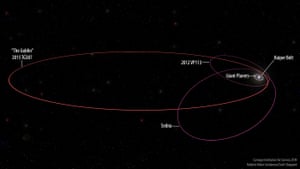Massively elongated orbit suggests object is influenced by theoretical giant Planet Nine in Oort Cloud region
An extremely distant dwarf planet, named The Goblin, has been discovered in observations that are redefining the outer reaches of the solar system.
Astronomers made the discovery while hunting for a hypothetical massive planet, known as Planet Nine, that is suspected to be in orbit far beyond Pluto in a mysterious region known as the Oort Cloud. Planet Nine has not yet been seen directly, but The Goblin appears to be under the gravitational influence of a giant unseen object, adding to astronomers’ certainty that it is out there.
The newly discovered icy world, estimated to be just 300km across, is in an extremely elongated orbit. At its closest, it gets about two and a half times as far from the sun as Pluto. Then it heads off to the outermost fringes of the solar system, to almost 60 times further out than Pluto, taking an astounding 40,000 years to loop once around the sun. For 99% of its orbit, it would be too faint to see.

The object is the third minor planet to have been found in the outer solar system, following the discoveries of Sedna and, recently, another object called 2012 VP113. And this region, which once appeared to be cold, dark and empty now appears to be a rich collection of exotic and extreme objects.
“We are only just now uncovering what the very outer solar system might look like and what might be out there,” said Scott Sheppard of the Carnegie Institution for Science in Washington DC and a member of the team. “We believe there are thousands of dwarf planets in the distant solar system. We are just seeing the tip of the iceberg right now.”
Intriguingly the orbits of the three objects discovered so far appear to be clustered together, suggesting that they are being shepherded by a giant, unknown object. This has pointed astronomers to the existence of a ninth, super-Earth sized planet.
Konstantin Batygin, assistant professor of planetary science at Caltech, who has worked on theoretical simulations of the hypothetical Planet Nine, described the latest observations as a “great discovery indeed”.
“Despite centuries of surveys, our understanding of the solar system remains incomplete,” he said. “This certainly adds to the growing ledger of … objects that show Planet Nine’s influence.”
The new dwarf planet’s formal name, assigned by the International Astronomical Union’s Minor Planet Center, is 2015 TG387. But it soon acquired its more memorable nickname because “human examination of the candidate slow-moving objects occurred in roughly the Halloween time frame,” explained David Tholen, of the University of Hawaii and a member of the observing team.
The discovery was made using the Japanese Subaru 8-metre telescope located on the dormant Mauna Kea volcano in Hawaii. The telescope is the only one in the world to be able to produce deep images capable of probing the outer reaches of the solar system, while also having a wide enough field of view to be able to image enough sky to discover rare objects. “With other large telescopes, it is like looking through a straw and thus they are good for observing things you know are there, but not for finding new things as their field of views are too small for covering large areas of sky,” said Sheppard.
The team will begin a new run of observations in November, with the hope of finding more objects, possibly including the elusive Planet Nine.
Source: The Guardian

































Leave a Comment
You must be logged in to post a comment.